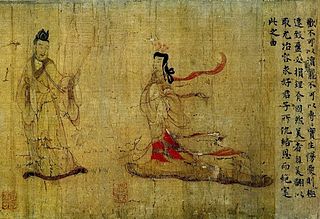Game theory is the study of mathematical models of strategic interactions among rational agents. It has applications in many fields of social science, used extensively in economics as well as in logic, systems science and computer science. Traditional game theory addressed two-person zero-sum games, in which a participant's gains or losses are exactly balanced by the losses and gains of the other participant. In the 21st century, game theory applies to a wider range of behavioral relations, and it is now an umbrella term for the science of logical decision making in humans, animals, as well as computers.

Cooperation takes place when a group of organisms works or acts together for a collective benefit to the group as opposed to working in competition for selfish individual benefit. In biology, many animal and plant species cooperate both with other members of their own species and with members of other species with whom they have relationships.
Experimental economics is the application of experimental methods to study economic questions. Data collected in experiments are used to estimate effect size, test the validity of economic theories, and illuminate market mechanisms. Economic experiments usually use cash to motivate subjects, in order to mimic real-world incentives. Experiments are used to help understand how and why markets and other exchange systems function as they do. Experimental economics have also expanded to understand institutions and the law.
In game theory, the centipede game, first introduced by Robert Rosenthal in 1981, is an extensive form game in which two players take turns choosing either to take a slightly larger share of an increasing pot, or to pass the pot to the other player. The payoffs are arranged so that if one passes the pot to one's opponent and the opponent takes the pot on the next round, one receives slightly less than if one had taken the pot on this round, but after an additional switch the potential payoff will be higher. Therefore, although at each round a player has an incentive to take the pot, it would be better for them to wait. Although the traditional centipede game had a limit of 100 rounds, any game with this structure but a different number of rounds is called a centipede game.
The dictator game is a popular experimental instrument in social psychology and economics, a derivative of the ultimatum game. The term "game" is a misnomer because it captures a decision by a single player: to send money to another or not. Thus, the dictator has the most power and holds the preferred position in this “game.” Although the “dictator” has the most power and presents a take it or leave it offer, the game has mixed results based on different behavioral attributes. The results – where most "dictators" choose to send money – evidence the role of fairness and norms in economic behavior, and undermine the assumption of narrow self-interest when given the opportunity to maximise one's own profits.
Inequity aversion (IA) is the preference for fairness and resistance to incidental inequalities. The social sciences that study inequity aversion include sociology, economics, psychology, anthropology, and ethology. Researches on inequity aversion aim to explain behaviors that are not purely driven by self-interests but fairness considerations.

The public goods game is a standard of experimental economics. In the basic game, subjects secretly choose how many of their private tokens to put into a public pot. The tokens in this pot are multiplied by a factor and this "public good" payoff is evenly divided among players. Each subject also keeps the tokens they do not contribute.
Backward induction is the process of determining a sequence of optimal choices by employing reasoning backward from the end of a problem or situation to its beginning, choice by choice. It involves examining the last point at which a decision is to be made and identifying the most optimal choice of action at that point. Using this information, one can then determine what to do at the second-to-last point of decision. This process continues backward until the best action for every possible point along the sequence is determined. Backward induction was first utilized in 1875 by Arthur Cayley, who discovered the method while attempting to solve the Secretary problem.

Social rejection occurs when an individual is deliberately excluded from a social relationship or social interaction. The topic includes interpersonal rejection, romantic rejection, and familial estrangement. A person can be rejected or shunned by individuals or an entire group of people. Furthermore, rejection can be either active by bullying, teasing, or ridiculing, or passive by ignoring a person, or giving the "silent treatment". The experience of being rejected is subjective for the recipient, and it can be perceived when it is not actually present. The word "ostracism" is also commonly used to denote a process of social exclusion.
Quantal response equilibrium (QRE) is a solution concept in game theory. First introduced by Richard McKelvey and Thomas Palfrey, it provides an equilibrium notion with bounded rationality. QRE is not an equilibrium refinement, and it can give significantly different results from Nash equilibrium. QRE is only defined for games with discrete strategies, although there are continuous-strategy analogues.
Strong reciprocity is an area of research in behavioral economics, evolutionary psychology, and evolutionary anthropology on the predisposition to cooperate even when there is no apparent benefit in doing so. This topic is particularly interesting to those studying the evolution of cooperation, as these behaviors seem to be in contradiction with predictions made by many models of cooperation. In response, current work on strong reciprocity is focused on developing evolutionary models which can account for this behavior. Critics of strong reciprocity argue that it is an artifact of lab experiments and does not reflect cooperative behavior in the real world.
A Rubinstein bargaining model refers to a class of bargaining games that feature alternating offers through an infinite time horizon. The original proof is due to Ariel Rubinstein in a 1982 paper. For a long time, the solution to this type of game was a mystery; thus, Rubinstein's solution is one of the most influential findings in game theory.
Social preferences describe the human tendency to not only care about one's own material payoff, but also the reference group's payoff or/and the intention that leads to the payoff. Social preferences are studied extensively in behavioral and experimental economics and social psychology. Types of social preferences include altruism, fairness, reciprocity, and inequity aversion. The field of economics originally assumed that humans were rational economic actors, and as it became apparent that this was not the case, the field began to change. The research of social preferences in economics started with lab experiments in 1980, where experimental economists found subjects' behavior deviated systematically from self-interest behavior in economic games such as ultimatum game and dictator game. These experimental findings then inspired various new economic models to characterize agent's altruism, fairness and reciprocity concern between 1990 and 2010. More recently, there are growing amounts of field experiments that study the shaping of social preference and its applications throughout society.
Social emotions are emotions that depend upon the thoughts, feelings or actions of other people, "as experienced, recalled, anticipated or imagined at first hand". Examples are embarrassment, guilt, shame, jealousy, envy, elevation, empathy, and pride. In contrast, basic emotions such as happiness and sadness only require the awareness of one's own physical state. Therefore, the development of social emotions is tightly linked with the development of social cognition, the ability to imagine other people's mental states, which generally develops in adolescence. Studies have found that children as young as 2 to 3 years of age can express emotions resembling guilt and remorse. However, while five-year-old children are able to imagine situations in which basic emotions would be felt, the ability to describe situations in which social emotions might be experienced does not appear until seven years of age.
Behavioral game theory seeks to examine how people's strategic decision-making behavior is shaped by social preferences, social utility and other psychological factors. Behavioral game theory analyzes interactive strategic decisions and behavior using the methods of game theory, experimental economics, and experimental psychology. Experiments include testing deviations from typical simplifications of economic theory such as the independence axiom and neglect of altruism, fairness, and framing effects. As a research program, the subject is a development of the last three decades.
Urs Fischbacher is a Swiss economist and professor of applied economic research at the University of Konstanz. He is director of the Thurgau Economic Institute, an affiliated institute of the University of Konstanz. He pioneered the field of software tools for experimental economics.
Inequity aversion in animals is the willingness to sacrifice material pay-offs for the sake of greater equality, something humans tend to do from early age. It manifests itself through negative responses when rewards are not distributed equally between animals. In controlled experiments it has been observed, to varying degrees, in capuchin monkeys, chimpanzees, macaques, marmosets, dogs, wolves, rats, crows and ravens. No evidence of the effect was found in tests with orangutans, owl monkeys, squirrel monkeys, tamarins, kea, and cleaner fish. Based on mixed results in experimental studies it may be concluded that some bonobos, baboons, gibbons, and gorillas are inequity averse. Disadvantageous inequity aversion, which occurs when the animal protests as it gets a lesser reward than another animal, is most common. But advantageous inequity aversion has been observed as well, in chimpanzees, baboons and capuchins: the animal protests when it gets a better reward. Scientists believe that sensitivity to inequity co-evolved with the ability to cooperate, as it helps to sustain benefitting from cooperation. There is little evidence for inequity aversion in non-cooperative species.
Sequential bargaining is a structured form of bargaining between two participants, in which the participants take turns in making offers. Initially, person #1 has the right to make an offer to person #2. If person #2 accepts the offer, then an agreement is reached and the process ends. If person #2 rejects the offer, then the participants switch turns, and now it is the turn of person #2 to make an offer. The people keep switching turns until either an agreement is reached, or the process ends with a disagreement due to a certain end condition. Several end conditions are common, for example:
The gift-exchange game, also commonly known as the gift exchange dilemma, is a common economic game introduced by George Akerlof and Janet Yellen to model reciprocacy in labor relations. The gift-exchange game simulates a labor-management relationship execution problem in the principal-agent problem in labor economics. The simplest form of the game involves two players – an employee and an employer. The employer first decides whether they should award a higher salary to the employee. The employee then decides whether to reciprocate with a higher level of effort due to the salary increase or not. Like trust games, gift-exchange games are used to study reciprocity for human subject research in social psychology and economics. If the employer pays extra salary and the employee puts in extra effort, then both players are better off than otherwise. The relationship between an investor and an investee has been investigated as the same type of a game.
A strategic bankruptcy problem is a variant of a bankruptcy problem in which claimants may act strategically, that is, they may manipulate their claims or their behavior. There are various kinds of strategic bankruptcy problems, differing in the assumptions about the possible ways in which claimants may manipulate.




